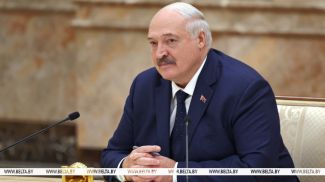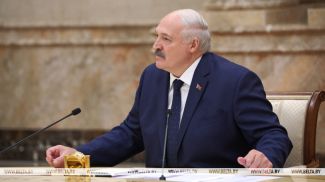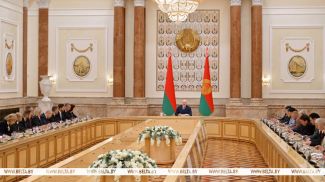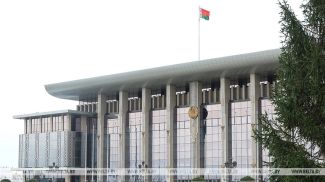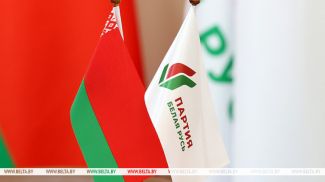
DZERZHINSK DISTRICT, 21 June (BelTA) – Belarusian President Aleksandr Lukashenko explained why he decided to come to the Lyakhovichi dairy farm of the Krutogorye-Petkovichi agricultural enterprise in Dzerzhinsk District, BelTA has learned.
The head of state noted that this is a new thing: the complex in Dzerzhinsk District is one of 20 facilities in the region, the construction of which was financed from the Minsk budget. In fact, Minsk consumes a significant part of products made in the region, therefore, it needs to help agricultural workers.
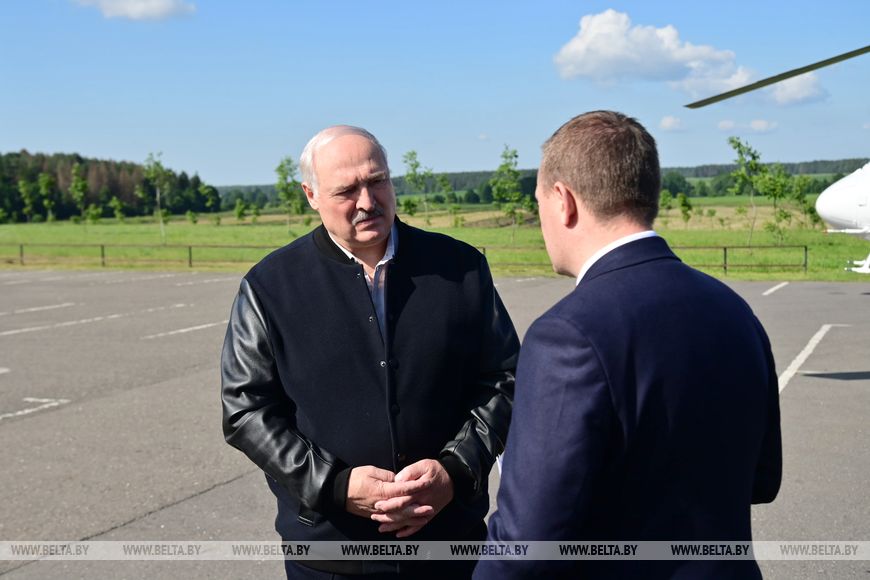
It is possible that a similar practice, but in a smaller scale, will be extended to other regions. “Minsk consumes products not only from Minsk Oblast, but also from Brest Oblast, Grodno Oblast, and other regions. Thus, when other governors learned that 20 dairy complexes were built here, they were frustrated: “Why in Minsk Oblast, and not in Brest Oblast...?” Indeed, why? Minsk consumes milk from Brest. Vladimir Yevgenievich [Minsk Mayor Vladimir Kukharev] implored: give me a year to finish things in Minsk Oblast, and then I’ll help build 1-1.5 complexes in other regions so that the other governors will not begrudge the Minsk Oblast governor,” said the head of state.
The second reason for the visit was that the complex in Dzerzhinsk District turned out to be optimal and relatively cheap to build. “This is the cheapest complex in the country. This is very important for us. We are commissioning more than a hundred complexes across the country this year. We need to clearly understand how much they cost us. If your complex is indeed the cheapest (it looks like that), we need to build more such complexes throughout the country. We don’t need complexes with bells and whistles, extravagant architecture and so on. Just a nice design, a good complex. A beautiful, normal project. We will replicate it throughout the country,” Aleksandr Lukashenko instructed.
The president emphasized the importance of building more dairy complexes like this: “We will not drop the construction of such complexes. If someone frets and giggles saying ‘here we go again with these complexes’... Again! All the milk produced here is of premium quality. Our people, including children, drink it. That’s why we have to move away from small farms towards building more such complexes.”

“It seems that over this time we have figured out how to build, where to build. In fact, crop production depends on the livestock complex,” the Belarusian leader emphasized.
The complex is designed for more than 1,100 dairy cows (three barns with 388 cattle places each). Intensive technology is used here and all production processes are automated. This allows producing equal amounts of milk all the year round.
The Lyakhovichi dairy complex is set to produce 9,428 tonnes of milk per year, with the milk yield per cow at 8,100 kg.
Minsk Oblast Governor Aleksandr Turchin explained how it was possible to cut costs during the construction. When existing old farms are transformed into dairy complexes, there is no need to build infrastructure from scratch, so this is not a greenfield project. “Plus, the facility remains operational during this time, generating money and revenue. We don’t have to wait two years to build a new facility and another year to buy equipment for it, while repaying loans,” he noted.
It has turned out that when cattle are relocated from old farms to new dairy complexes, their productivity increases within a short period of time.
It was also possible to save on design and estimate documentation, because a standard design was used for all 20 complexes. There was only one case when the design had to be adjusted to fit a specific location. And many construction works were done by the enterprise’s own workforce.
Aleksandr Lukashenko urged to make long-term calculations of logistics costs and not rely indefinitely on existing infrastructure: “Indeed, construction will cost you less. But if livestock farming is concentrated in one place, you will have to transport feed from an area of around 20 kilometers for years. You choose location based on the availability of good roads, but later on you will pay extra for logistics as you will have to bring feed from a more distant place. You have to calculate everything thoroughly.”
The head of state was also informed about social security commitments of the enterprise. There are several dozen villages in the vicinity. The company has recently helped purchase shops-on-wheels to bring products to rural dwellers. “Well done! I have already explained many times why we support agriculture, and why this is one of priorities of the government policy. Since the Soviet times it has been crucial for our country. We need to keep supporting the countryside,” the Belarusian leader emphasized.
Aleksandr Lukashenko added that Dzerzhinsk is a satellite town of Minsk. “We will put serious effort into developing this town,” the president remarked.
The head of state noted that this is a new thing: the complex in Dzerzhinsk District is one of 20 facilities in the region, the construction of which was financed from the Minsk budget. In fact, Minsk consumes a significant part of products made in the region, therefore, it needs to help agricultural workers.

It is possible that a similar practice, but in a smaller scale, will be extended to other regions. “Minsk consumes products not only from Minsk Oblast, but also from Brest Oblast, Grodno Oblast, and other regions. Thus, when other governors learned that 20 dairy complexes were built here, they were frustrated: “Why in Minsk Oblast, and not in Brest Oblast...?” Indeed, why? Minsk consumes milk from Brest. Vladimir Yevgenievich [Minsk Mayor Vladimir Kukharev] implored: give me a year to finish things in Minsk Oblast, and then I’ll help build 1-1.5 complexes in other regions so that the other governors will not begrudge the Minsk Oblast governor,” said the head of state.
The second reason for the visit was that the complex in Dzerzhinsk District turned out to be optimal and relatively cheap to build. “This is the cheapest complex in the country. This is very important for us. We are commissioning more than a hundred complexes across the country this year. We need to clearly understand how much they cost us. If your complex is indeed the cheapest (it looks like that), we need to build more such complexes throughout the country. We don’t need complexes with bells and whistles, extravagant architecture and so on. Just a nice design, a good complex. A beautiful, normal project. We will replicate it throughout the country,” Aleksandr Lukashenko instructed.
The president emphasized the importance of building more dairy complexes like this: “We will not drop the construction of such complexes. If someone frets and giggles saying ‘here we go again with these complexes’... Again! All the milk produced here is of premium quality. Our people, including children, drink it. That’s why we have to move away from small farms towards building more such complexes.”

“It seems that over this time we have figured out how to build, where to build. In fact, crop production depends on the livestock complex,” the Belarusian leader emphasized.
The complex is designed for more than 1,100 dairy cows (three barns with 388 cattle places each). Intensive technology is used here and all production processes are automated. This allows producing equal amounts of milk all the year round.
The Lyakhovichi dairy complex is set to produce 9,428 tonnes of milk per year, with the milk yield per cow at 8,100 kg.
Minsk Oblast Governor Aleksandr Turchin explained how it was possible to cut costs during the construction. When existing old farms are transformed into dairy complexes, there is no need to build infrastructure from scratch, so this is not a greenfield project. “Plus, the facility remains operational during this time, generating money and revenue. We don’t have to wait two years to build a new facility and another year to buy equipment for it, while repaying loans,” he noted.
It has turned out that when cattle are relocated from old farms to new dairy complexes, their productivity increases within a short period of time.
It was also possible to save on design and estimate documentation, because a standard design was used for all 20 complexes. There was only one case when the design had to be adjusted to fit a specific location. And many construction works were done by the enterprise’s own workforce.
Aleksandr Lukashenko urged to make long-term calculations of logistics costs and not rely indefinitely on existing infrastructure: “Indeed, construction will cost you less. But if livestock farming is concentrated in one place, you will have to transport feed from an area of around 20 kilometers for years. You choose location based on the availability of good roads, but later on you will pay extra for logistics as you will have to bring feed from a more distant place. You have to calculate everything thoroughly.”
The head of state was also informed about social security commitments of the enterprise. There are several dozen villages in the vicinity. The company has recently helped purchase shops-on-wheels to bring products to rural dwellers. “Well done! I have already explained many times why we support agriculture, and why this is one of priorities of the government policy. Since the Soviet times it has been crucial for our country. We need to keep supporting the countryside,” the Belarusian leader emphasized.
Aleksandr Lukashenko added that Dzerzhinsk is a satellite town of Minsk. “We will put serious effort into developing this town,” the president remarked.





